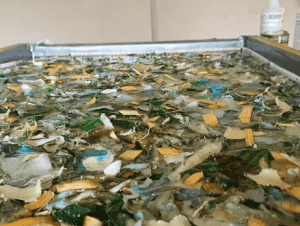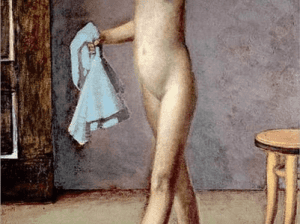
The Tower of Blue Horses, also known as Der Turm der blauen Pferde in its native German, is an expressionist oil painting that was completed by the German artist Franz Marc in 1913. It was considered to be one of his best works, but in 1945 it vanished without a trace.
The Tower of Blue Horses was a substantial piece of artwork, measuring 200 centimetres by 130 centimetres (6 feet 7 inches by 4 feet 3 inches). The majority of the picture is taken up by a frontal view of four horses, three of which are predominantly blue and are arranged in a tier to the right of the picture’s centre. The horses are facing the viewer but have their heads turned to the left; at least one writer found that the leading horse appeared to be “only a little less than life size.” There is an abstract landscape to the left of their rumps, which serve as the focal point of the picture. Above this landscape is an orange rainbow superimposed on a yellow background. The leading horse has a crescent moon emblazoned across its chest, and there are crosses all over its body that resemble stars.
During the summer of 1913, Marc created the painting. A preliminary sketch in ink and gouache survives in the form of a new year’s postcard for that year to the poet Else Lasker-Schuler. This postcard was one of 28 painted postcards that the artist sent to her, and Else Lasker-Schuler answered the artist’s postcards with illustrated letters that were later used in her novel Malik. The sketch of the Blue Horses incorporates both her favourite colour, blue, as well as some personal symbols she has, such as the moon and stars. The Munich State Graphics Collection has taken this item into their archive. In the autumn of that year, Marc showed seven of his paintings at the First German Autumn Salon (Erster Deutscher Herbstsalon). One of those paintings was a large-format painting.
Following the conclusion of World War I, one of the works by Marc that was purchased for the newly established contemporary annexe of the Berlin National Gallery, which was located in the Kronprinzenpalais, was titled “The Tower of Blue Horses.” It was taken from there as part of the Nazi regime’s “cleansing” of modern art works, and it was displayed at the Degenerate Art exhibition that opened in Munich in July of 1937. The painting was taken down, and it was not a part of the exhibition when it opened in Berlin. This was done in response to a protest by war veterans who were upset that Marc had lost his life while serving his country in the war. Eighty thousand Reichsmarks was the price that was placed on it at the time. In the spring of 1936, it was then transferred to Hermann Goring’s custody as part of a select group of valuable modernist paintings that also included two other works by Marc. At the time, its value had increased to 20,000 RM, and it was included in this group. Goring is believed to have sold at least some of these items at a significant profit; however, he does not appear to have sold The Tower of Blue Horses, which was reported missing when the war was over.
Edwin Redslob (de), an art historian who later became Rector of the Free University of Berlin, wrote in 1977 that he had seen the painting in the Haus am Waldsee in Zehlendorf, Berlin, while still under Soviet occupation, i.e., in the first half of 1945. Additionally, the journalist Joachim Nawrocki reported having seen it in the adjacent youth hostel in the winter of the Berlin blockade, 1948/49, with two or three slits cut in it. Other statements and theories regarding the whereabouts of the painting have been published. These include the possibility that it was destroyed at Carinhall in 1945 when Goring ordered the house to be blown up as the Russians advanced towards it, that it was in the Prussian Chamber of Deputies, and that it was in Switzerland, most likely in a bank safe in Zurich. In 2001, an art collector claimed to have been offered the painting for sale. Art historian Roland Marz (de) put the painting on the catalogue cover when he organised an exhibition on the German Expressionists in 1986 at the (then East German) National Gallery. He did this in the hopes that “a little old lady from the eastern Ore Mountains would come into his office and unroll a canvas out of which the crystals of blue pigment would spill.” Marz (de) has continued to search for the painting, but he has not been successful in finding it.
Recommend0 recommendationsPublished in Art History, Artworks





Responses